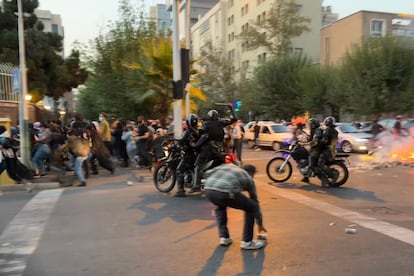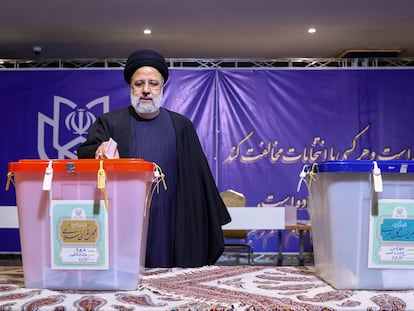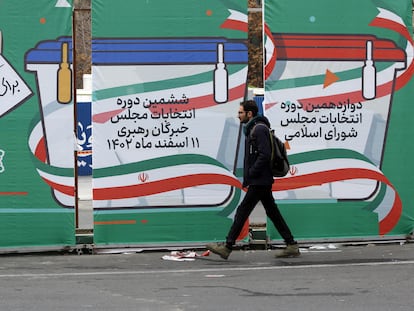Iran committed ‘crimes against humanity’ during repression of protests over Mahsa Amini’s death, UN fact-finding mission says
The report commissioned by the United Nations accuses Iranian security and paramilitary forces of killing and torturing protesters with ‘encouragement and endorsement by high-level state authorities and senior members of state institutions’


Security and paramilitary forces of the Islamic Republic of Iran killed hundreds of people on the orders of the authorities. They also detained, imprisoned, tortured, or subjected to enforced disappearance, among other “inhumane acts,” numerous Iranian citizens during the crackdown on anti-regime protests that began on September 16, 2022, when Mahsa Amini, a 22-year-old Kurdish-Iranian woman, died in police custody three days after being arrested in Tehran for wearing the veil in an “inappropriate” manner. These are the conclusions reached by the United Nations-appointed Independent Fact-Finding Mission on the Islamic Republic of Iran in a report released Friday, coinciding with International Women’s Day.
The text is a summary of the final document that the mission will present to the U.N. Human Rights Council before March 18. It states that the “serious human rights violations” committed during the repression of the demonstrations by the Iranian regime “amount to crimes against humanity,” some of which could “fall within the jurisdiction of the International Court of Justice” of the United Nations. Among these crimes, that of “gender-based violence” against the Iranian women who led the protests, whose slogan was “Women, Life, Freedom,” stands out.
These crimes were not “random,” the report states. They were part of “series of extensive, sustained and continuing acts that individually constitute human rights violations, directed against women, girls and persons expressing support for gender equality and the rights of women and girls.” Such “extensive” violence and the fact that it was carried out with “encouragement and endorsement by high-level state authorities and senior members of state institutions” lead the authors of the report to conclude that the perpetrators were acting on “instructions” from the regime.
“Thousands of women, men and children were detained throughout the country” without any public data being provided on their numbers, the document stresses, citing a figure provided by NGOs: 60,000 detainees. The average age of those arrested was 15. The mission reveals that “hundreds” of children, some as young as 10, were detained, imprisoned with adults, or sent to mental health institutions or reformatories.
Iran did not allow the members of the mission, jurists Sara Hossain, Shaheen Sardar Ali and Viviana Krsticevic, to travel to the country. The three investigators qualify the report’s data on the basis of official and private documents, medical records, remote interviews with victims and witnesses — the latter double-checked — and satellite images. Their findings, the document warns, “are not exhaustive,” so the repression in Iran could have been worse than the report lays out.
The first of the deaths investigated was that of Mahsa Amini, which triggered the protests. The report states that shortly after her arrest by the morality police, she was admitted to Tehran’s Kasra hospital “already brain-dead” with “trauma to Ms. Amini’s body, inflicted while in the custody of the morality police.” The mission is therefore “satisfied” that Amini was “subjected to physical violence that led to her death.”
Following the outbreak of the mostly “peaceful” protests, the document states, several hundred demonstrators or bystanders perished in the repression. “As of September 2023, a credible figure was of 551 people killed, among them as many as 49 women and 68 children. Women and men were injured in similar numbers. Deaths were recorded in at least 26 of the 31 provinces, with the highest number of victims in regions with minority populations, in particular in Sistan and Baluchestan province, the Kurdish regions of the country (Kurdistan and Kermanshah) and parts of Western Azerbaijan.”

“Extrajudicial executions”
The report notes that policemen, members of the Revolutionary Guards and Basij [paramilitary] militiamen were firing at protesters in situations where there was no risk to themselves. “Protesting in front of a government building or a security base, chanting slogans, helping others or driving a car nearby are inherently peaceful acts. Victims killed and injured by lethal force while they or others engaged in such activities did not pose an imminent threat.” The report concludes that “targeted killings of protesters constituted extrajudicial executions.”
On other occasions, “less lethal” weapons such as rubber bullets were used, but served, for example, to blind one or both eyes of numerous protesters, including children. Those injured in the demonstrations often had no access to medical care, as the Ministry of Health instructed medical professionals to report anyone seeking treatment.
Another “pattern” identified by the U.N. fact-finding mission was arbitrary arrests for “dancing, chanting or writing slogans on walls and honking car horns.” Also arrested were family members of protesters, health workers, journalists, students, teachers, activists, artists, and athletes who showed solidarity with the protests.
“Detainees, including children underwent long and repeated interrogation sessions, during which they were blindfolded or hooded and subjected to various forms of physical and psychological abuse amounting to torture. That included physical assault, such as punching, kicking, beating, flogging and burning, the use of electric shocks, suspension and stress positions. Numerous detainees, including children, were forcibly administered, or injected with, unknown substances,” says the independent U.N. mission, which reports “several cases of deaths in custody as a result of torture.”
When the detainees finally appeared in court, they did so without a lawyer of their choice and without being allowed access to their files to see what evidence there was against them. Under these conditions of deprivation of “due process,” the nine demonstrators executed for their involvement in the protests were sentenced to hanging. Another 19 people are on death row, the document denounces.
The U.N. fact-finding mission concludes its report by encouraging member states that include the concept of universal justice in their legislation to open investigations into the repression in Iran. It also urges them to grant asylum and visas to the women, men, and children of the “Women, Life, Freedom” movement, whose “courage and resilience” it highlights.
Sign up for our weekly newsletter to get more English-language news coverage from EL PAÍS USA Edition
Tu suscripción se está usando en otro dispositivo
¿Quieres añadir otro usuario a tu suscripción?
Si continúas leyendo en este dispositivo, no se podrá leer en el otro.
FlechaTu suscripción se está usando en otro dispositivo y solo puedes acceder a EL PAÍS desde un dispositivo a la vez.
Si quieres compartir tu cuenta, cambia tu suscripción a la modalidad Premium, así podrás añadir otro usuario. Cada uno accederá con su propia cuenta de email, lo que os permitirá personalizar vuestra experiencia en EL PAÍS.
¿Tienes una suscripción de empresa? Accede aquí para contratar más cuentas.
En el caso de no saber quién está usando tu cuenta, te recomendamos cambiar tu contraseña aquí.
Si decides continuar compartiendo tu cuenta, este mensaje se mostrará en tu dispositivo y en el de la otra persona que está usando tu cuenta de forma indefinida, afectando a tu experiencia de lectura. Puedes consultar aquí los términos y condiciones de la suscripción digital.
More information
Archived In
Últimas noticias
Most viewed
- Reinhard Genzel, Nobel laureate in physics: ‘One-minute videos will never give you the truth’
- Oona Chaplin: ‘I told James Cameron that I was living in a treehouse and starting a permaculture project with a friend’
- Pablo Escobar’s hippos: A serious environmental problem, 40 years on
- Why we lost the habit of sleeping in two segments and how that changed our sense of time
- Chevy Chase, the beloved comedian who was a monster off camera: ‘Not everyone hated him, just the people who’ve worked with him’










































